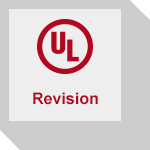
Revision
July 25, 2022
UL 497
UL Revision
Edition 7
Published Date: July 25, 2022
ANSI Approved: July 25, 2022
Scope
004970-000000-0000001 Scope
1.1 These requirements cover protectors for paired-conductor communications circuits to be used in accordance with Article 800 of the National Electrical Code, NFPA 70.
1.2 As covered by these requirements, a communications circuit protector consists of single- and multiple-pair air gap arresters, gas tube arresters, or solid state arresters, with or without fuses or other voltage-limiting devices. A circuit protector is intended to protect equipment, wiring, and personnel against the effects of excessive potentials and currents in telephone lines caused by lightning, contacts with power conductors, power induction, and rises in ground potential.
1.3 This standard does not cover the following:
a) Lightning protective devices for the protection of secondary distribution wiring systems and equipment.
b) Antenna discharge units for radio- and television-receiving appliances.
c) Lightning conductor and air terminals for connection of lightning rods for building protection.
d) Protectors for fire alarm signaling circuits that are covered by the Standard for Protectors for Data Communications and Fire-Alarm Circuits, UL 497B.
e) Secondary Protectors for Communications Circuits, UL 497A.
f) Transient Voltage Surge Suppressors, UL 1449.
1.4 A product that contains features, characteristics, components, materials, or systems new or different from those covered by the requirements in this standard, and that involves a risk of fire or of electric shock or injury to persons shall be evaluated using appropriate additional component and end-product requirements to maintain the level of safety as originally anticipated by the intent of this standard. A product whose features, characteristics, components, materials, or systems conflict with specific requirements or provisions of this standard does not comply with this standard. Revision of requirements shall be proposed and adopted in conformance with the methods employed for development, revision, and implementation of this standard.